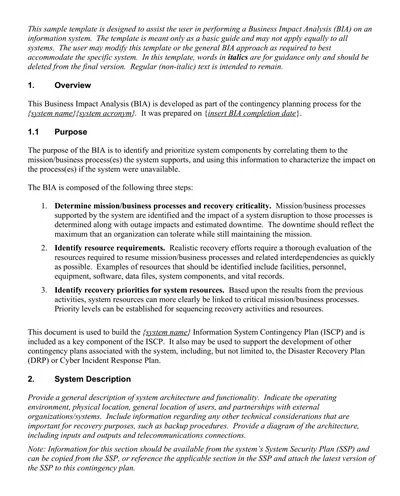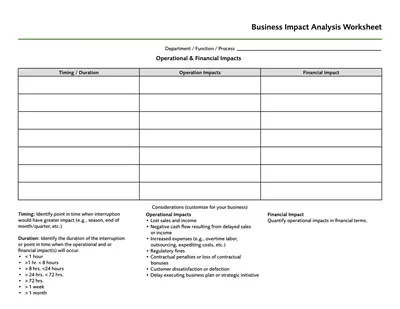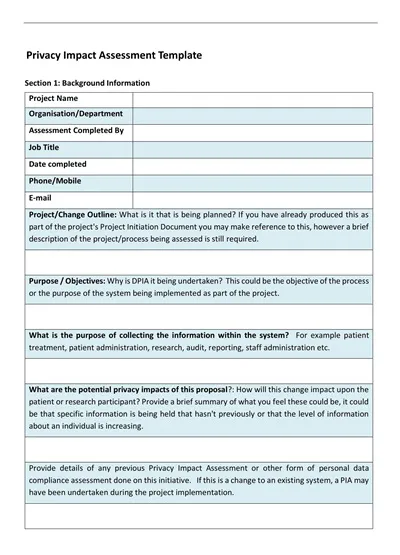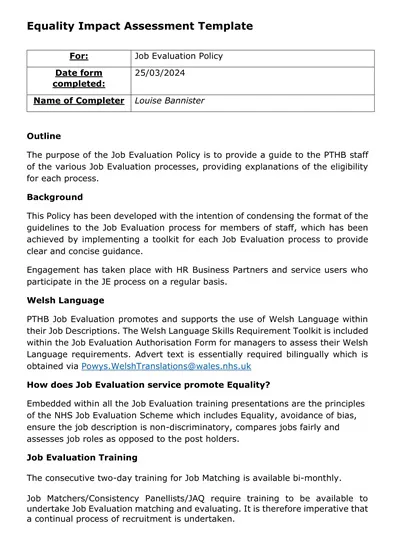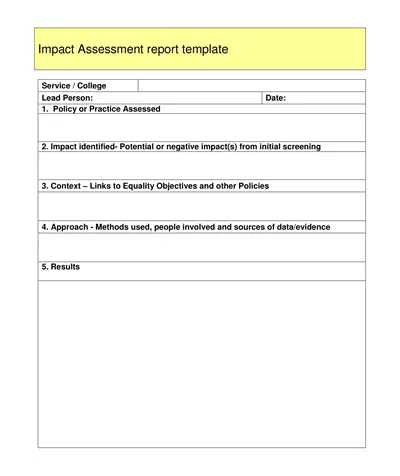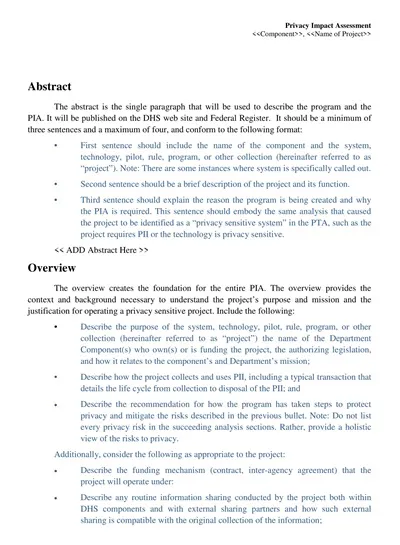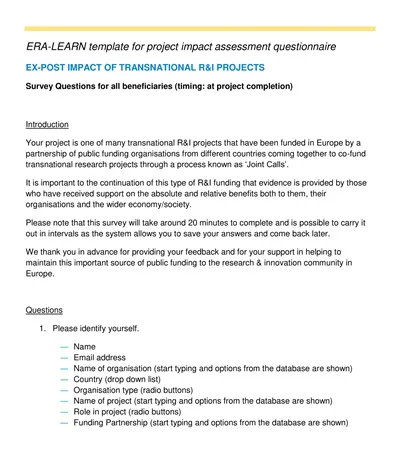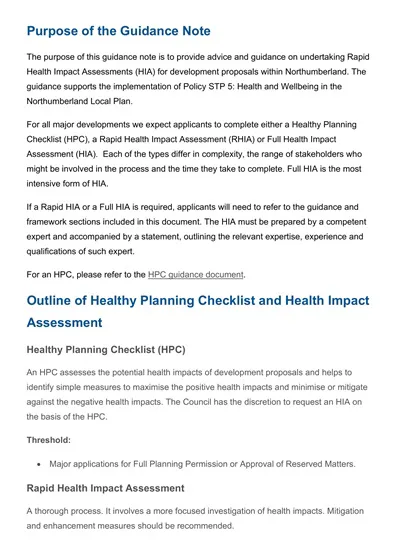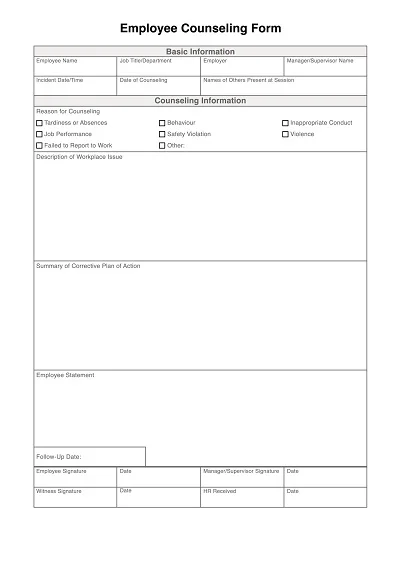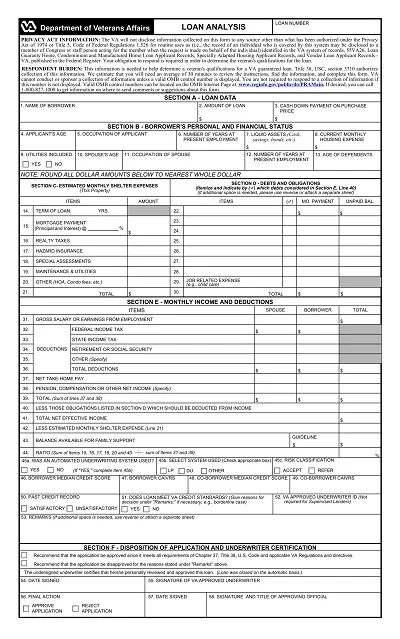An Impact Assessment Template is a pre-defined document for assessing potential outcomes at a particular proposed project, policy, or other forms of decision from environmental, social, economic, and organizational perspectives. It offers a defined framework for determining possible risks, advantages, stakeholders, and mitigation measures, so all of these factors are taken into account before deployment.
By employing a consistent framework, the template allows decision-makers to include the bigger picture of the decision they are making, hold themselves accountable, and encourage more thoughtful and responsible planning. It is widely used for application areas such as project management, policy development, environmental planning, and business strategy.
Download Free Sample Impact Assessment Templates
What is Impact Assessment?
Impact Assessment is a systematic process of identifying, analyzing, and predicting the potential consequences—both positive and negative—of proposed action, project, policy, or development before it takes place. The objective is to predict the likely effects on people, the environment, the economy, and other important areas that can result in serious decisions and pervasive negative impacts that can be mitigated or reduced.
Presentation of concept: Impact Assessments are extensively used in sectors such as environmental planning, business strategy, public policy, and social development. They assist in the fact that projects or decisions are sustainable, environmentally friendly, and aligned with legal, ethical, and community values. The marrow frequently includes stakeholder communication, risk scrutiny, and advice concerning mitigation of or incentivization of impact.
Types of Impact Assessment
Below is the Impact Assessment explained with headings and short paragraphs:
1. Environmental Impact Assessment (EIA)
Such an assessment targets the potential environmental impact of a particular project or development. It covers issues like air and water pollution, aiming to noise, wasteland degradation, loss of biodiversity, and other ecological problems. EIA secures that environmental protection is an integral part of the planning and decision-making process.
2. Social Impact Assessment (SIA)
A Social Impact Assessment is used to look for out how a project, policy or plan may influence people, social communities, and organizations. This includes effects on health, education, housing, culture and way of life. SIA is critical in learning and directing the human outcomes of change.
3. Economic Impact Assessment
This evaluation evaluates the possible financial consequences of a project or advice, including employment, adjustments in incomes, investment prospects, as well as business impacts towards local or national economies. It assists people interested to determine whether the suggested act is cost effective or sustainable.
4. Health Impact Assessment (HIA)
Health Impact Assessment is concerned with how a plan or development may impact the physical and mental health of the population. It includes direct health effects as well as indirect effects such as access to healthcare, clean air, water, and safe working situations.
5. Strategic Environmental Assessment (SEA)
Unlike EIA, which is project-based, SEA considers the environmental impact at a higher level, such as at the policy, plan, and programme level. It means that environmental concerns are embedded in the strategic planning process.
6. Gender Impact Assessment
This kind of evaluation looks at how policies or projects may have various outcomes for men and women. It empowers to recognize and counter gender inequalities, promoting the idea that opinions are an affirmation of the parity that goes to everybody her gender.
7. Cultural Impact Assessment
Cultural Impact Assessment assesses the potential effects on cultural heritage, customary practices, traditional values and customs, and approach, particularly in areas occupied by an indigenous population. It serves as a means to safeguard cultural entities and appreciate the customary patterns of living.
8. Technology Impact Assessment (TIA)
Technology Impact Assessment is concentrated on the social, economic, ethical, and environmental consequences of new/emerging technology. These are precisely the areas where innovation as a rule is played out, such as artificial intelligence, genetic engineering, and digital platforms.
Why is Impact Assessment important?
Impact Assessment is useful because it informs decision-makers as to what might happen as a result of a proposed new project, policy, or action before intervention takes place. Sorts of impacts for environmental, social, economic, and health impacts, it ensures that risks are detected early and the negative effects can be mitigated or removed.
Also, to facilitate open dialogue between citizens, planners, businesses, and civil society to better decision-making on issues of the economy, resources, community, and the environment, this process fosters sustainable development, protects communities and ecosystems, and supports transparency and accountability in planning. Furthermore, impact assessment requires the engagement of stakeholders, can meet the concerns, and win the trust of interested parties. Finally, it results in more informed, rational, and balanced decisions that correspond to long-term goals and public interests.
Key Components of Impact Assessment
Here are the pri- cons of an Impact Assessment, usually in most of the Assessment processes:
- Project or Policy Description: Detailed description of the proposed activity, consisting of the objective, address, scale, and duration of the activity. This defines what is being assessed.
- Baseline Study: An examination of the current environmental, social, economic, or health conditions of the area that may be affected. It assists in assessing the degree of the change when the project is executed.
- Impact Identification: A thorough analysis of every possible effect, good and bad, direct and indirect, anticipated or presumably resulting from the proposed action.
- Impact Prediction and Evaluation: Predicting the importance, severity, and duration of every impact. This step determines how severe or positive the effects recognised could be over time.
- Mitigation Measures: Ideas for preventing, minimizing or compensating for the harmful effects. This could be varying from design changes, safeguard measures or community back-up programs.
- Alternatives Analysis: An evaluation of alternative options to achieve the project’s objectives with lower or fewer impacts. This demonstrates whether more sustainable or socially responsible options are available.
- Stakeholder Engagement: Talking to people, communities, and organizations and other people that may be impacted. This guarantees that they are taken into account by decision makers.
- Monitoring and Follow-Up: A mechanism to monitor the real effects once the project is carried out and confirm that the measures intended for mitigation are achieving their goal. It prevents accommodations when there are surprises.
- Documentation and Reporting: Preparing a formal Impact Assessment Report summarising results, analysis, and recommendations in a clear and accountable way for regulators and stakeholders.
Benefits of Impact Assessment
Impact Assessment gives numerous advantages by offering that projects, strategies, or schemes determined are well-defined, culpable and economical. One of its great benefits, that it enables early detection of potential to-harm, and hence formulation of mitigation strategy to reduce to-harm to the environment, society and economic.
It fosters transparency and responsibility when it is obligatory to take into consideration the interest of stakeholders in the process of decision making – it builds up trust, after all, it reduces conflicts. Impact Assessment also enables legal and regulatory compliance, preventing the organisation from being held up, penalised, or soiled. Further, it provokes thinking on alternative solutions, frequently giving more refined, efficient, and socially acceptable results. In the long term, it promotes sustainability and a better quality of life for the concerned communities.
Who Needs the Impact Assessment Template?
Impact Assessment coordination is necessary by an extensive variety of people and stakeholders engaged in planning, decision-making, or implementation projects, and the policies that can have significant impacts on the people, the environment, or the economy. Here’s who typically needs it:
1. Government Agencies
Regulatory bodies and public sector departments rely on the template to assess the impact of new policies, infrastructure project, or legal reforms and judge as to whether they good matches for public interest and sustainability.
2. Project Managers and Developers
Users of the template are individuals, organizations and enterprises which are planning, executing construction, industrial and infrastructure projects including assessment of risks, fulfillment of regulatory requirements and obtaining of official approvals.
3. Environmental Consultants
Experts contracted to mitigate environmental effects use a standardised outline to guarantee comprehensive, sensible, and compliant analyses.
4. Non-Governmental Organizations (NGOs)
Impact assessments are used by NGOs to assess social or environmental outcomes of projects, especially in advocacy or community development projects.
5. Corporate Entities and Businesses
Manufacturers that are entering the market with a new product, technology, or expansion use impact assessments to assess how the business will affect the economy, the environment, and perhaps society, all the more so as part of their sustainability or ESG (Environmental, Social, Governance) reporting.
6. Urban Planners and Policy Makers
Urban and regional planners employ it so they can determine how land use plans, transport networks, or the policies over zoning might impact communities or the environment.
7. Academics and Researchers
For students analyzing policy, environmental science, public health, or development, scholars must apply templates for core analysis in reports, process documents, case studies, or impact evaluation.
How to Create an Impact Assessment Template
Here is a somewhat detailed step-by-step guide on how to create an Impact assessment template, in bullet points for ease:
- Set the Objective of the Template: Specifically define what the evaluation is meant to accomplish (e.g., environmental consequence, policy analysis, project planning).
- Identify Key Sections to Include: Decide on a regular section, for example, project summary, baseline conditions, stakeholder interpretation, impact assessment, and mitigation methods
- Include Project/Policy Description Fields: Include fields for the proposed activity to include its objectives, scope, location, duration and stakeholders to be involved.
- Add a Baseline Study Section: Provide a space for recording information on current conditions of the environment, society, or economy.
- Create Impact Identification Tables: Create a stipulation for detailing possible effects (favorable and unfavorable) and grouping them (e.g., the short-term, long-term, direct, or indirect).
- Include an Impact Evaluation Matrix: Add a matrix or scales to gauge the importance of each impact (e.g., low, medium, high).
- Provide Space for Mitigation Strategies: Insert a section with suggestions to lessen or counteract adverse effects.
- Include an Alternatives Analysis Section: Allow users to be able to compare the proposed action with other alternatives that will likely have less impacts.
- Add Stakeholder Engagement Details: Make fields to track consultations, feedback received, and how complaints have been dealt with.
- Insert Monitoring and Follow-Up Plans: Provide a template to create the setup of monitoring indicators, responsibility, and timeline.
- Ensure Compliance and Legal Checks: Make provision for a checklist or a Section of conformity with applicable laws, regulations, and standards.
- Use Clear Headings and Consistent Format: Make the layout accessible and user-friendly, and accommodate notes or attachments, if required.
- Test and Review the Template: Before making broad use of it, try out the template on a test project and refer back based on feedback.

